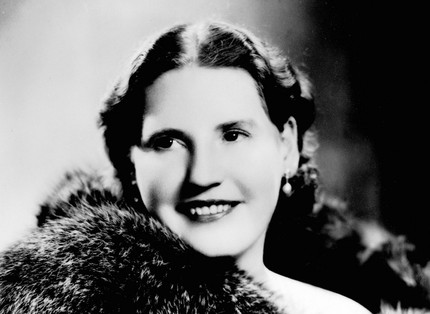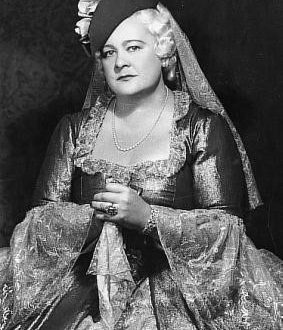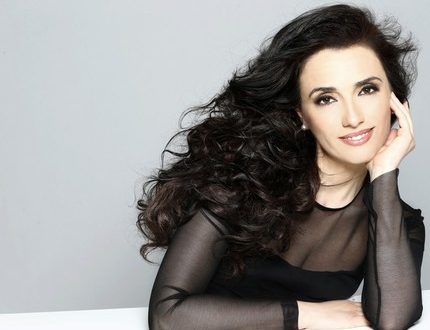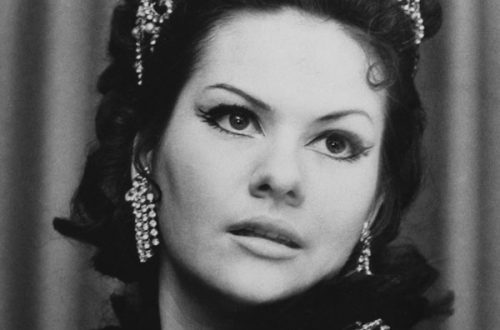
Thanksgiving Girl (Kirsten Flagstad) |
Kirsten Flagstad

The famous prima donna of the Metropolitan Francis Alda, who performed with almost all the major masters of the world opera scene, said: “After Enrico Caruso, I knew only one truly great voice in the opera of our day – this is Kirsten Flagstad.” Kirsten Flagstad was born on July 12, 1895 in the Norwegian city of Hamar, in the family of conductor Mikhail Flagstad. Mother was also a musician – a fairly well-known pianist and accompanist at the National Theater in Oslo. Is it any wonder that since childhood, Kirsten studied piano and singing with her mother, and at the age of six she sang Schubert’s songs!
At thirteen, the girl knew the parts of Aida and Elsa. Two years later, Kirsten’s classes began with a well-known vocal teacher in Oslo, Ellen Schitt-Jakobsen. After three years of classes, Flagstad made her debut on December 12, 1913. In the Norwegian capital, she performed the role of Nuriv in E. d’Albert’s opera The Valley, which was popular in those years. The young artist was liked not only by the ordinary public, but also by a group of wealthy patrons. The latter gave the singer a scholarship so that she could continue her vocal education.
Thanks to financial support, Kirsten studied in Stockholm with Albert Westwang and Gillis Bratt. In 1917, returning home, Flagstad regularly performs in opera performances at the National Theatre.
“It could be expected that, with the undoubted talent of the young singer, she would relatively quickly be able to take a prominent place in the vocal world,” writes V.V. Timokhin. – But that did not happen. For twenty years, Flagstad remained an ordinary, modest actress who willingly took on any role offered to her, not only in opera, but also in operetta, revue, and musical comedies. There were, of course, objective reasons for this, but much can be explained by the character of Flagstad herself, who was absolutely alien to the spirit of “premiership” and artistic ambition. She was a hard worker, who least of all thought about personal gain “for herself” in art.
Flagstad got married in 1919. A little time passes and she leaves the stage. No, not because of the protest of her husband: before the birth of her daughter, the singer lost her voice. Then he returned, but Kirsten, fearing overload, for some time preferred “light roles” in operettas. In 1921, the singer became a soloist with the Mayol Theater in Oslo. Later, she performed at the Casino Theater. In 1928, the Norwegian singer accepted an invitation to become a soloist with the Stura Theater in the Swedish city of Gothenburg.
Then it was difficult to imagine that in the future the singer would specialize exclusively in Wagnerian roles. At that time, from the Wagner parties in her repertoire were only Elsa and Elizabeth. On the contrary, she seemed to be a typical “universal performer”, singing thirty-eight roles in operas and thirty in operettas. Among them: Minnie (“Girl from the West” by Puccini), Margarita (“Faust”), Nedda (“Pagliacci”), Eurydice (“Orpheus” by Gluck), Mimi (“La Boheme”), Tosca, Cio-Cio-San, Aida, Desdemona, Michaela (“Carmen”), Evryanta, Agatha (“Euryante” and Weber’s “Magic Shooter”).
Flagstad’s future as a Wagnerian performer is largely due to a combination of circumstances, since she had all the conditions to become an equally outstanding “Italian” singer.
When Isolde, the famous Wagnerian singer Nanni Larsen-Todsen, fell ill during the staging of Wagner’s musical drama Tristan und Isolde in Oslo in 1932, they remembered Flagstad. Kirsten did a great job with her new role.
The famous bass Alexander Kipnis was completely captivated by the new Isolde, who considered that the place of Flagstad was at the Wagner festival in Bayreuth. In the summer of 1933, at another festival, she sang Ortlinda in The Valkyrie and The Third Norn in The Death of the Gods. The following year, she was entrusted with more responsible roles – Sieglinde and Gutrune.
At the performances of the Bayreuth Festival, representatives of the Metropolitan Opera heard Flagstad. The New York theater just at that time needed a Wagnerian soprano.
The debut of Flagstad on February 2, 1935 at the New York Metropolitan Opera in the role of Sieglinde brought the artist a real triumph. The next morning the American newspapers trumpeted the birth of the greatest Wagnerian singer of the XNUMXth century. Lawrence Gilman wrote in the New York Herald Tribune that this is one of those rare occasions when, obviously, the composer himself would be happy to hear such an artistic embodiment of his Sieglinde.
“The listeners were captivated not only by Flagstad’s voice, although the very sound of it could not but arouse delight,” writes V.V. Timokhin. – The audience was also captivated by the amazing immediacy, humanity of the artist’s performance. From the very first performances, this distinctive feature of the artistic appearance of Flagstad was revealed to the New York audience, which can be especially valuable for singers of the Wagnerian orientation. Wagnerian performers were known here, in whom the epic, monumental sometimes prevailed over the truly human. The heroines of Flagstad were as if illuminated by sunlight, warmed by a touching, sincere feeling. She was a romantic artist, but listeners identified her romanticism not so much with high dramatic pathos, a penchant for vivid pathos, but with amazing sublime beauty and poetic harmony, that quivering lyricism that filled her voice …
All the richness of emotional shades, feelings and moods, the entire palette of artistic colors contained in Wagner’s music, was embodied by Flagstad by means of vocal expressiveness. In this regard, the singer, perhaps, had no rivals on the Wagner stage. Her voice was subject to the most subtle movements of the soul, any psychological nuances, emotional states: enthusiastic contemplation and awe of passion, dramatic uplift and poetic inspiration. Listening to Flagstad, the audience was introduced to the most intimate sources of Wagner’s lyrics. The basis, the “core” of her interpretations of the Wagnerian heroines were amazing simplicity, spiritual openness, inner illumination – Flagstad was undoubtedly one of the greatest lyric interpreters in the entire history of Wagnerian performance.
Her art was alien to external pathos and emotional forcing. A few phrases sung by the artist were enough to create a vividly outlined image in the listener’s imagination – there was so much affectionate warmth, tenderness and cordiality in the singer’s voice. Flagstad’s vocalism was distinguished by rare perfection – each note taken by the singer captivated with fullness, roundness, beauty, and the timbre of the artist’s voice, as if incorporating the characteristic northern elegiacism, gave Flagstad’s singing an inexpressible charm. Her plasticity of vocalization was amazing, the art of legato singing, which the most prominent representatives of Italian bel canto could envy … “
For six years, Flagstad performed regularly at the Metropolitan Opera exclusively in the Wagnerian repertoire. The only part of a different composer was Leonora in Beethoven’s Fidelio. She sang Brunnhilde in The Valkyrie and The Fall of the Gods, Isolde, Elizabeth in Tannhäuser, Elsa in Lohengrin, Kundry in Parsifal.
All performances with the participation of the singer went with constant full houses. Only nine performances of “Tristan” with the participation of the Norwegian artist brought the theater an unprecedented income – more than one hundred and fifty thousand dollars!
The triumph of Flagstad at the Metropolitan opened the doors of the largest opera houses in the world to her. On May 1936, 2, she made her debut with great success in Tristan at London’s Covent Garden. And on September XNUMX of the same year, the singer sings for the first time at the Vienna State Opera. She sang Isolde, and at the end of the opera, the audience called the singer thirty times!
Flagstad first appeared before the French public in 1938 on the stage of the Parisian Grand Opera. She also played the role of Isolde. In the same year, she made a concert tour of Australia.
In the spring of 1941, having returned to her homeland, the singer actually stopped performing. During the war, she only left Norway twice – to participate in the Zurich Music Festival.
In November 1946, Flagstad sang in Tristan at the Chicago Opera House. In the spring of the following year, she made her first post-war concert tour of US cities.
After Flagstad arrived in London in 1947, she then sang the leading Wagner parts at the Covent Garden Theater for four seasons.
“Flagstad was already over fifty years old,” writes V.V. Timokhin, – but her voice, it seemed, was not subject to time – it sounded as fresh, full, juicy and bright as in the memorable year of the first acquaintance of Londoners with the singer. He easily endured huge loads that could have been unbearable even for a much younger singer. So, in 1949, she performed the role of Brunnhilde in three performances for a week: The Valkyries, Siegfried and The Death of the Gods.
In 1949 and 1950 Flagstad performed as Leonora (Fidelio) at the Salzburg Festival. In 1950, the singer took part in the production of Der Ring des Nibelungen at Milan’s La Scala Theatre.
In early 1951, the singer returned to the stage of the Metropolitan. But she did not sing there for long. On the threshold of his sixtieth birthday, Flagstad decides to leave the stage in the near future. And the first of a series of her farewell performances took place on April 1, 1952 at the Metropolitan. After she had sung the title role in Gluck’s Alceste, George Sloan, chairman of the Met’s board of directors, came on stage and said that Flagstad had given her last performance at the Met. The whole room began to chant “No! Not! Not!”. Within half an hour, the audience called the singer. Only when the lights were turned off in the hall did the audience begin to reluctantly disperse.
Continuing the farewell tour, in 1952/53 Flagstad sang with great success in the London production of Purcell’s Dido and Aeneas. On November 1953, 12, it was the turn of parting with the singer of the Parisian Grand Opera. On December XNUMX of the same year, she gives a concert at the Oslo National Theater in honor of the fortieth anniversary of her artistic activity.
After that, her public appearances are only episodic. Flagstad finally said goodbye to the public on September 7, 1957 with a concert in London’s Albert Hall.
Flagstad did a lot for the development of the national opera. She became the first director of the Norwegian Opera. Alas, the progressing illness forced her to leave the director’s post after the end of the debut season.
The last years of the famous singer were spent in her own house in Kristiansand, built at the time according to the project of the singer – a two-story white villa with a colonnade decorating the main entrance.
Flagstad died in Oslo on December 7, 1962.





